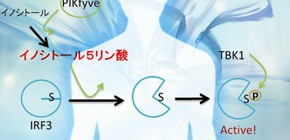
Clarification of immune response to viral infection
a step towards the development of effective vaccines acting as immunostimulators
Under the leadership of AKIRA Shizuo (Professor & Director, Immunology Frontier Research Center [WPI- IFReC ], Osaka University) and KAWASAKI Takumi (Assistant Professor) and KAWAI Taro ( Associate Professor, Nara Institute of Science and Technology--both also affiliated with IFReC), a group of researchers clarified that immune responses to viral infection were controlled by inositol 5-phosphate, a kind of phosphatide in the cellular membrane.
This group developed a screening system for TBK1 (TANK-binding kinase 1)-IRF3 (interferon regulatory factor-3) activation and found that phosphatidylinositol-5-phosphate (PtdIns5P) increased TBK1-IRF3 signaling.
This group discovered that PtdIns5P in cells increased during viral infection of the cells. This group also found that PtdIns5P bound to IRF3 and this binding promoted IRF3 phosphorylation. As a result, IRF3 activated and induced cytokine production. Additionally, the administration of synthesized PtdIns5P and antibody to mice induced antigen-specific antibody production.
From these findings, it is expected that the results of this group's research will lead to the possible development of effective vaccines making use of PtdIns5P.
Abstract
Innate immune receptors, notably Toll-like receptors (TLRs) and RIG-I-like receptors (RLRs), sense viral infection and activate transcription factors, including interferon regulatory factor-3 (IRF3), to induce type I interferon (IFN). We demonstrate that the lipid phosphatidylinositol-5-phosphate (PtdIns5P) is increased upon viral infection and facilitates type I IFN production by binding to IRF3 and its upstream kinase TBK1 and promoting TBK1-mediated IRF3 phosphorylation and activation. Additionally, we determine that PtdIns5P is produced through the kinase PIKfyve, which phosphorylates PtdIns to generate PtdIns5P. Accordingly, PIKfyve knockdown or pharamoclogical inhibition decreases PtdIns5P levels and type I IFN production after TLR or RLR stimulation, and results in increased viral replication. A synthetic PtdIns5P, C8-PtdIns5P, promotes IRF3 phosphorylation and cytokine production in dendritic cells and acts as an adjuvant to boost immune responses in immunized mice. Thus, PtdIns5P produced during viral infection is a second messenger that targets the TBK1-IRF3 axis to elicit antiviral immunity.

Figure 1

Figure 2

Figure 3
To learn more about this research, please read the full research report entitled " The second messenger phosphatidylinositol-5-phosphate facilitates antiviral innate immune signaling " at this page of the Cell Host & Microbe website.
Related links :
